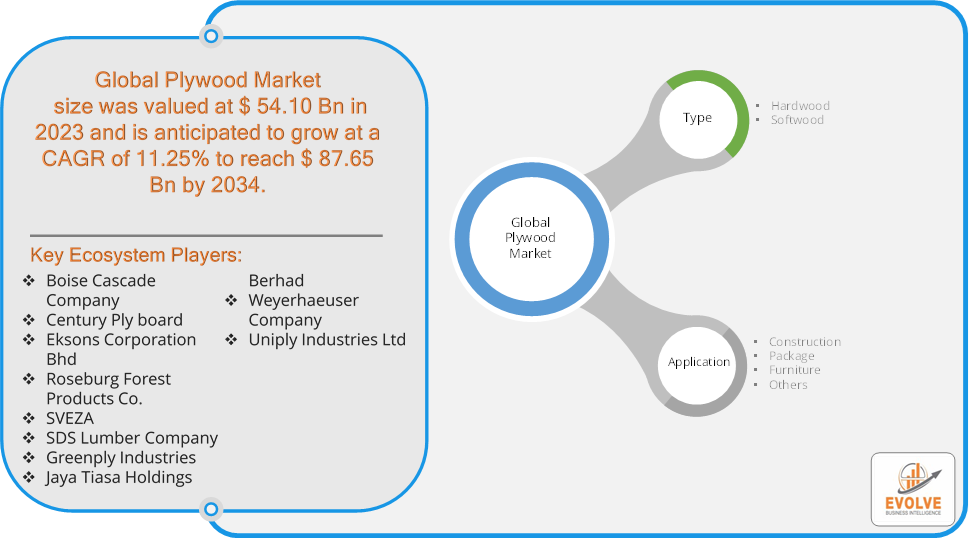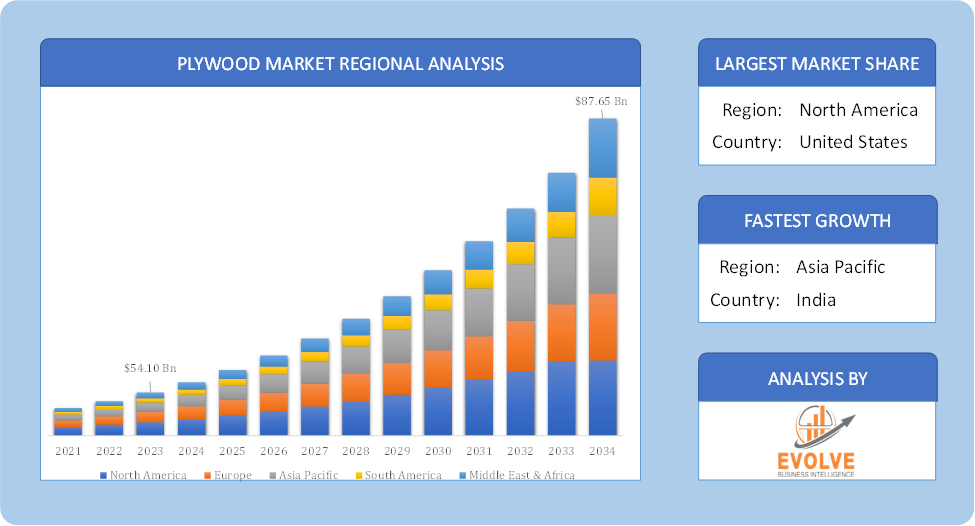Plywood Market Overview
The Plywood Market Size is expected to reach USD 87.65 Billion by 2034. The Plywood Market industry size accounted for USD 54.10 Billion in 2023 and is expected to expand at a compound annual growth rate (CAGR) of 11.25% from 2021 to 2034. The Plywood Market refers to the global industry involved in the production, distribution, and sale of plywood, a type of engineered wood product made by gluing together thin layers of wood veneers, with the grain of each layer typically oriented perpendicular to the adjacent layer. This process gives plywood its strength, stability, and resistance to warping, making it a popular choice in various applications.
The plywood market is dynamic, influenced by factors like technological advancements in manufacturing, environmental regulations, and consumer preferences for sustainable and high-quality materials.
Global Plywood Market Synopsis
The COVID-19 pandemic had a significant impact on the plywood market. Lockdowns and restrictions on movement led to disruptions in the supply chain, causing delays in the availability of raw materials like timber. Many sawmills and veneer production facilities were either shut down or operated at reduced capacity, leading to a shortage of plywood. Many plywood manufacturing plants were forced to shut down or operate at reduced capacity due to health guidelines, labour shortages, and a drop in demand during the initial phase of the pandemic. The construction industry, a major consumer of plywood, experienced a slowdown due to halted projects, reduced investments, and uncertainty in the real estate market. This led to a sharp decline in demand for plywood during the early stages of the pandemic. The trend of home improvement and renovation, driven by remote working and the need for better home environments, continued to support demand for plywood, particularly in residential applications. The pandemic heightened awareness of environmental issues, leading to a greater demand for sustainable and certified plywood products. Consumers and businesses became more conscious of the environmental impact of their purchases, driving demand for plywood from responsibly managed forests.
Plywood Market Dynamics
The major factors that have impacted the growth of Plywood Market are as follows:
Drivers:
Ø Technological Advancements in Plywood Manufacturing
Innovations in plywood manufacturing, such as the use of advanced adhesives and treatments, have enhanced the durability, moisture resistance, and fire retardancy of plywood, making it suitable for a wider range of applications. The development of specialized plywood types, such as marine plywood for moisture-prone areas or fire-rated plywood for safety applications, is expanding the market. Plywood is commonly used in the packaging industry for making crates, pallets, and other wooden packaging solutions. The growth of industries like manufacturing, logistics, and e-commerce, which require durable packaging materials, drives demand for plywood.
Restraint:
- Perception of Fluctuations in Raw Material Prices
Plywood production relies heavily on the availability of quality timber. Fluctuations in timber prices due to factors like deforestation, logging restrictions, and environmental regulations can lead to increased production costs and reduced profit margins for plywood manufacturers. Events such as natural disasters, political instability, or pandemics can disrupt the supply chain for raw materials, leading to shortages and increased prices, thereby restraining market growth.
Opportunity:
⮚ Increased Use in Furniture and Interior Design
The growing trend toward modular and DIY furniture presents an opportunity for plywood manufacturers. Plywood’s versatility and ease of use make it ideal for modular furniture production, appealing to both manufacturers and consumers in this segment. As more homeowners and businesses invest in interior design and renovation, particularly in the wake of the pandemic, the demand for aesthetically pleasing, durable, and customizable plywood products is expected to rise. The rise of e-commerce platforms provides an opportunity for plywood manufacturers and distributors to reach a broader customer base, including DIY enthusiasts and small businesses. Developing robust online sales channels and digital marketing strategies can significantly boost sales.
Plywood Market Segment Overview
Based on Type, the market is segmented based on Hardwood and Softwood. The softwood segment dominated the market. Around 80% of the timber produced worldwide comes from softwood. There are many uses, but furniture and woodwork are two of the most common ones. Because it is typically less expensive, softwood is used for furniture more frequently than hardwood. This is so that softwood trees, which grow more quickly and are therefore simpler and less expensive to produce, can be used. Because softwood is more readily regenerated than hardwood, it is more environmentally beneficial.
By Application
Based on Application, the market segment has been divided into Construction, Package, Furniture and Others. The furniture segment dominated the market. The primary component of furniture, like cabinets and wardrobes, is plywood. The majority of readily available wood furniture, including sofas, vanities, and wooden doors, is made of this material. Compared to solid wood components, it is a more affordable option. It is more durable than solid wood parts for the same cost.
Global Plywood Market Regional Analysis
Based on region, the global Plywood Market has been divided into North America, Europe, Asia-Pacific, the Middle East & Africa, and Latin America. North America is projected to dominate the use of the Plywood Market followed by the Asia-Pacific and Europe regions.
 Plywood North America Market
Plywood North America Market
North America holds a dominant position in the Plywood Market. The U.S. is a major consumer and producer of plywood, driven by robust construction and renovation activities, particularly in residential and commercial sectors. The demand for sustainable and high-quality plywood is rising, supported by environmental regulations and green building standards. The U.S. also has a well-developed manufacturing base, though it faces competition from imports.
Plywood Asia-Pacific Market
The Asia-Pacific region has indeed emerged as the fastest-growing market for the Plywood Market industry. China is the largest producer and consumer of plywood globally. The country’s rapid urbanization, large-scale infrastructure projects, and strong manufacturing sector drive significant demand for plywood. China is also a major exporter of plywood, although it faces competition from other countries in the global market and India is experiencing robust growth in the plywood market due to increasing urbanization, infrastructure development, and rising disposable incomes. The demand for plywood in residential and commercial construction is growing, supported by government housing initiatives and real estate development.
Competitive Landscape
The global Plywood Market is highly competitive, with numerous players offering a wide range of software solutions. The competitive landscape is characterized by the presence of established companies, as well as emerging startups and niche players. To increase their market position and attract a wide consumer base, the businesses are employing various strategies, such as product launches, and strategic alliances.
Prominent Players:
- Boise Cascade Company
- Century Ply board
- Eksons Corporation Bhd
- Roseburg Forest Products Co.
- SVEZA
- SDS Lumber Company
- Greenply Industries
- Jaya Tiasa Holdings Berhad
- Weyerhaeuser Company
- Uniply Industries Ltd.
Key Development
In July 2022, Boise Cascade acquired Coastal Plywood Company and its manufacturing operations in Havana, Chapman, Florida, and Alabama. With this acquisition, Boise Cascade will expand its manufacturing capacity and strengthen its market position ahead of its competitors.
Scope of the Report
Global Plywood Market, by Type
- Hardwood
- Softwood
Global Plywood Market, by Application
- Construction
- Package
- Furniture
- Others
Global Plywood Market, by Region
- North America
- US
- Canada
- Mexico
- Europe
- UK
- Germany
- France
- Italy
- Spain
- Benelux
- Nordic
- Rest of Europe
- Asia Pacific
- China
- Japan
- South Korea
- Indonesia
- Austalia
- Malaysia
- India
- Rest of Asia Pacific
- South America
- Brazil
- Argentina
- Rest of South America
- Middle East & Africa
- Saudi Arabia
- UAE
- Egypt
- South Africa
- Rest of Middle East & Africa
| Parameters | Indicators |
|---|---|
| Market Size | 2033: USD 87.65 Billion |
| CAGR (2023-2033) | 11.25% |
| Base year | 2022 |
| Forecast Period | 2023-2033 |
| Historical Data | 2021 (2017 to 2020 On Demand) |
| Report Coverage | Revenue Forecast, Competitive Landscape, Growth Factors, and Trends |
| Key Segmentations | Type, Application |
| Geographies Covered | North America, Europe, Asia-Pacific, South America, Middle East, Africa |
| Key Vendors | Boise Cascade Company, Century Ply board, Eksons Corporation Bhd, Roseburg Forest Products Co., SVEZA, SDS Lumber Company, Greenply Industries, Jaya Tiasa Holdings Berhad, Weyerhaeuser Company and Uniply Industries Ltd. |
| Key Market Opportunities | · Increased Use in Furniture and Interior Design · Online Sales Channels |
| Key Market Drivers | · Technological Advancements in Plywood Manufacturing · Growth in the Packaging Industry |
REPORT CONTENT BRIEF:
- High-level analysis of the current and future Plywood Market trends and opportunities
- Detailed analysis of current market drivers, restraining factors, and opportunities in the future
- Plywood Market historical market size for the year 2021, and forecast from 2023 to 2033
- Plywood Market share analysis at each product level
- Competitor analysis with detailed insight into its product segment, Government & Defense strength, and strategies adopted.
- Identifies key strategies adopted including product launches and developments, mergers and acquisitions, joint ventures, collaborations, and partnerships as well as funding taken and investment done, among others.
- To identify and understand the various factors involved in the global Plywood Market affected by the pandemic
- To provide a detailed insight into the major companies operating in the market. The profiling will include the Government & Defense health of the company’s past 2-3 years with segmental and regional revenue breakup, product offering, recent developments, SWOT analysis, and key strategies.







